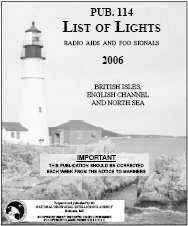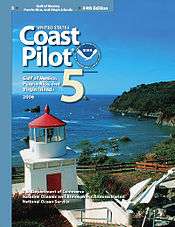List of lights
A list of lights is a publication describing lighthouses and other aids to maritime navigation. Most such lists are published by national hydrographic offices.
 The front cover of a List of Lights volume. | |
| Purpose: | Provide info on navigational aids outside the U.S. |
|---|---|
| Publication Frequency: | Yearly |
| Published by: | National Geospatial-Intelligence Agency (NGA) |
| Available Online: | Yes[1] |
United States
The United States National Geospatial-Intelligence Agency publishes a list of lights. The book is usually referred to as the List of Lights, and should not be confused with the U.S. Coast Guard's Light List.
The List of Lights is published in seven volumes, as Publication numbers 110 through 116. Each volume contains lights and other aids to navigation that are maintained by or under the authority of other governments.
Each volume corresponds to a defined geographic region, and contains more complete information about the navigational aids than can be conveniently shown on nautical charts. New editions are published annually for every volume.
In addition to information on lighted aids to navigation and sound signals in foreign waters, the NGA List of Lights provides information on storm signals, signal stations, racons, radiobeacons, and radio direction finder calibration stations located at or near lights. Publication number 117, Radio Navigational Aids, is the primary source for details on radio navigational aids.
The List of Lights does not include information on lighted buoys inside harbors. It does include certain aeronautical lights situated near the coast; however, these lights are not designed for marine navigation and are subject to unreported changes.
Notices to mariners provided by other countries are the main source for correctional information source for the Lists of Lights, however other sources, such as ship reports, are also used.
See also
Similar publications are published by the U.S. Coast Guard for U.S. civilian and commercial use, and by the Canadian Coast Guard.
- American Practical Navigator
- Buoy
- Coast Pilots
- Light List
- Local Notice to Mariners
- Notice to mariners
- Sailing Directions
External links
- List of Lights Online
- List of Lights, Buoys and Fog Signals (4 Volumes), Canadian Coast Guard
References
- "Archived copy". Archived from the original on 2007-03-07. Retrieved 2007-03-08.CS1 maint: archived copy as title (link)
Attribution
![]()
